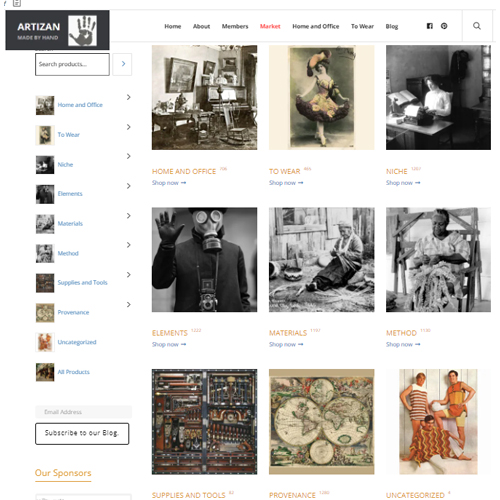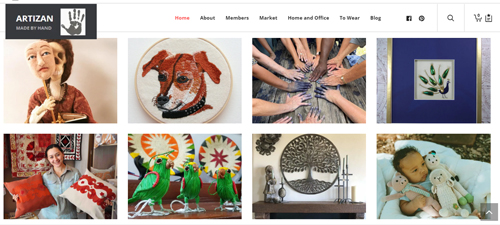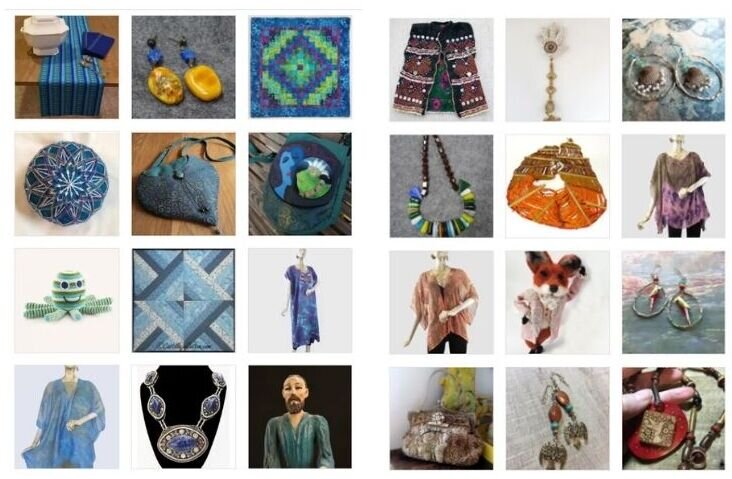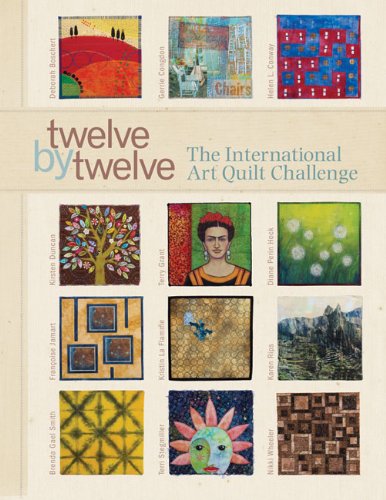by guest blogger Rachel Biel
Rachel Biel shares the story of an online handmade community and the labor of love that built it.

In September of 2013, I launched Artizan Made, a collective of online shops selling handmade products. The structure went through several incarnations until I found a mix of tools that work well for us. A blog post on our site explains these tools and some of our history. That explains the how. My focus here on Artsy Shark is on the why.
A bit of background
In September of 2019, my server destroyed both Artizan Made and another site I ran, TAFA: The Textile and Fiber Art List. I had started two other projects at that time and was overwhelmed and devastated by the loss. Covid hit and I had to shut down the other projects. I didn’t have the energy to re-do the site build up for Artizan until February of 2022. I knew how much work it would be and wasn’t sure I wanted to go through it again. Once I got started, I remembered why I like this so much and how others might also want to use this model as a tool.
How we use it
Our focus is on home décor and eco-fashion. Each member has a profile and 50 products in our Market. Most members have their own shops, either on Etsy or on their own sites and we import from them and link back. Some just have portfolios on their sites and can use our cart at no extra cost. The products are tagged with whatever fits from our 200 categories which then get featured in our blog and then promoted on Facebook and Pinterest. The goal is to create a destination that showcases high quality handmade products and then send people over to the members’ sites. We are mostly marketing, not selling.

We have an international focus and work with studio artists, fair traders, small importers and ethical vintage. As an example, the Member Profiles (shown above) represent needle felting and painting from Israel, embroidery from Switzerland, fiber art from Texas, embroidery from Germany, home décor and garments from Tajikistan, crafts from the Peruvian Amazon, metal art from Haiti, and crocheted children’s toys from Bangladesh.
The Market has top categories which break into subcategories, also visible in the sidebar. Vintage photos (image at top of page) were used for fun, but also to give recognition to the past and to the techniques we honor.
The 200 categories allow the products to show up in different ways. They include the obvious ones for home and fashion, but also include techniques, colors, materials and many other groupings. Some examples are our Blue category and Beaded Category.

The Blue Category (left) and Beaded Category on the Artizan Made website.
How can others use this model? Our setup is labor intensive, but could be simplified. What if a group of five friends got together and shared a site? Each person could have one task and they could pool their resources, have a shared mailing list, divide social media tasks and so on. The focus could be by location or perhaps by theme. A market with children’s products might have toys, clothing, educational resources and even food!
Several years ago, a group of 12 textile artists in my online community came together for an exercise. They had known each other on the web for years, but lived in different countries and had never met as a group in “real” life. In their own words:
We are twelve quilt artists who embarked on an online art challenge together in September 2007. For four years, we each made a 12×12 inch quilted art piece on a designated theme or colour palette. For 2012, we made rectangular pieces, 20×12 inches. Sweet, our final 2012 challenge was revealed on 12 December 2012 – 12/12/12!
The results are showcased here:
- Theme Series (2007-2009)
- Colorplay Series (2009-2011)
- 2012 Series (2012)

The Twelve by Twelve International Art Quilt Challenge collaboration
Their collaboration led to creating a website, publishing books, and exhibiting. We followed them with excitement! Most of them are still creating and have their own sites. What if they had added a market to their 12×12 site? With all of the attention they generated as a group, they could have benefitted by selling their other work as well.
Why create a Market?
Like a chamber of commerce, a market can represent you. There are many groups and organizations out there that you can join, but if you have an idea that could generate attention, this model might be just the thing.
I have worked with the handmade community for over 30 years, both as an artist and as an advocate and find that competition is much harder now than it was back then. Artists who sell online have so many tasks to keep up with that making their own work becomes a challenge. Working with a group can alleviate some of the marketing burden.
Final thoughts
- Most of my peers have sold on Etsy or are still there. Etsy has generated controversy ever since it lost its commitment to the handmade community. But I feel that it is still the best platform to have a shop especially as international selling becomes more complex. However, Etsy’s search engine has always been weak and for many sellers, it’s hard to get seen there. Importing products from there to a Market and then linking back helps a targeted audience find that shop.
- Keeping products up to date on a Market is a challenge. As a solution, we have text saying “this is an example of a past product I have made. Visit my shop to see what is currently available”. If the work has a similar look, the customer should find something they like. If products change a lot over time, we can do a new import.
- At least one person in the group needs to be pretty techy. Or, everyone can pitch in to pay for someone to run things for them.
- A smaller group with less products and fewer categories would be much easier to manage. We have 30 members on Artizan Made with a final goal of 200. That will give us enough income to afford some pricier marketing and give me a stipend for my time.
I am happy to answer questions about this model. Please visit my blog post on Artizan Made and leave your questions there so that others might learn from our exchange.
Imagination is the beginning of creation. You imagine what you desire, you will what you imagine and at last you create what you will.
― George Bernard Shaw
Guest blogger Rachel Biel worked with the handmade community for over 30 years and sees it as part of a larger lifestyle that lives well with our planet. Her path led to 18 years in Brazil, 4 years at St. Olaf College, and 20 years Chicago and she finally landed in Paducah, Kentucky in 2005.


Thank you for letting us share Artizan Made’s model, Carolyn, and for all the work you have put in over the years to help artists and the creative community find the tools they need to succeed! Artsy Shark is a great resource!
This is so informative and interesting. I have been a part of ArtizanMade and TAFA since Rachel launched them and I have really enjoyed Rachel’s support and friendship. It has been a lovely way to see what other designers and creators are doing, around the world.